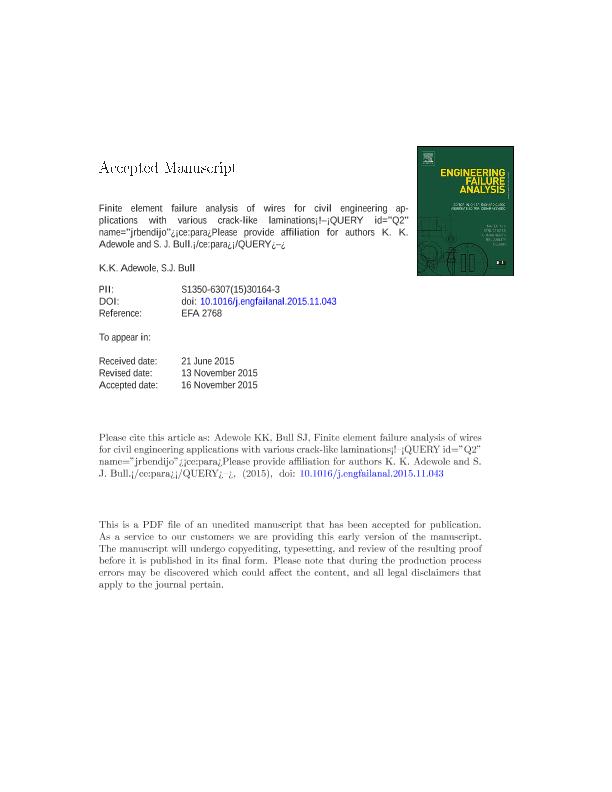Mostrar el registro sencillo del ítem
dc.contributor.author
Adewole, Kazeem Kayode

dc.contributor.author
Bull, Steve J.

dc.date.available
2017-05-03T14:22:34Z
dc.date.issued
2015-11-18
dc.identifier.citation
Adewole, Kazeem Kayode; Bull, Steve J.; Finite element failure analysis of wires for civil engineering applications with various crack-like laminations; Pergamon-Elsevier Science Ltd; Engineering Failure Analysis; 60; 18-11-2015; 229-249
dc.identifier.issn
1350-6307
dc.identifier.uri
http://hdl.handle.net/11336/15915
dc.description.abstract
This paper presents the finite element (FE) failure predictions and analyses of a typical wire for civil engineering applications with various crack-like lamination types (Single and double), geometries (straight-end and inclined-end) and orientations (longitudinal, lateral and transverse). FE prediction and analysis of the failure of notched pre-cracked wires with a surface across-the-thickness crack-like lamination validated with experimental results are also presented. The FE predicted fracture shape for the notched pre-cracked wires that consists of a cup and cone fracture shape below the bottom tip of the surface across-the-thickness crack-like lamination agrees with the experimental fracture shape. Wires with the double straight-end and double inclined-end crack-like/line-type laminations exhibit a “slant-middle W” and a “zigzag” fractures respectively. Above and below the lateral mid-width across-the-thickness lamination, the wires with the lateral mid-width across-the-thickness lamination exhibit a combination of a transverse mid-thickness flat fracture that is perpendicular to the lateral mid-width across-the-thickness lamination and negatively inclined slant fractures on each side of the mid-thickness flat fracture at the remaining outer edges of the wire's thickness. On both the front and back sides of the transverse mid-thickness across-the-width lamination, the wires with the transverse mid-thickness across-the-width lamination exhibit a combination of transverse flat fractures parallel to the transverse mid-thickness across-the-width lamination and positively inclined slant fractures at the outer edges of the wire's thickness. FE failure analysis reveals that fracture initiations do not always begin at the termini of every longitudinal crack-like/line-type lamination as reported in a published fractographic failure analysis report of wires with longitudinal crack-like laminations. Fracture initiation only begins at the termini/tip of longitudinal inclined-end crack-like laminations and at the termini/tip of transverse and lateral laminations. FE failure analysis also reveals that wires with single straight-end, double straight-end and double inclined-end longitudinal crack-like/line-type laminations do not exhibit cup and cone fractures as reported. This work further demonstrates the need to employ FE failure analysis as a complimentary or alternative failure analysis approach where the destruction/alteration of the fracture markings by corrosion could affect the accuracy of fractographic failure analysis.
dc.format
application/pdf
dc.language.iso
eng
dc.publisher
Pergamon-Elsevier Science Ltd

dc.rights
info:eu-repo/semantics/embargoedAccess
dc.rights.uri
https://creativecommons.org/licenses/by-nc-sa/2.5/ar/
dc.subject
Cup And Cone Fracture
dc.subject
Finite Elements Failure Analysis
dc.subject
Fracture Behaviour
dc.subject
Crack-Like Lamination
dc.subject
Open-V Fracture
dc.subject
Slant Middle W Fracture
dc.subject
Zigzag Fracture
dc.subject
Wire
dc.subject.classification
Otras Ingeniería Civil

dc.subject.classification
Ingeniería Civil

dc.subject.classification
INGENIERÍAS Y TECNOLOGÍAS

dc.title
Finite element failure analysis of wires for civil engineering applications with various crack-like laminations
dc.type
info:eu-repo/semantics/article
dc.type
info:ar-repo/semantics/artículo
dc.type
info:eu-repo/semantics/publishedVersion
dc.date.updated
2017-05-02T18:03:09Z
dc.journal.volume
60
dc.journal.pagination
229-249
dc.journal.pais
Países Bajos

dc.journal.ciudad
Amsterdam
dc.description.fil
Fil: Adewole, Kazeem Kayode. University Of Newcastle; Reino Unido. Consejo Nacional de Investigaciones Científicas y Técnicas. Centro Científico Tecnológico Conicet - Nordeste. Instituto de Modelado e Innovación Tecnológica. Universidad Nacional del Nordeste. Facultad de Ciencias Exactas Naturales y Agrimensura. Instituto de Modelado e Innovación Tecnologica; Argentina
dc.description.fil
Fil: Bull, Steve J.. University Of Newcastle; Reino Unido
dc.journal.title
Engineering Failure Analysis

dc.rights.embargoDate
2017-11-30
dc.relation.alternativeid
info:eu-repo/semantics/altIdentifier/doi/http://dx.doi.org/10.1016/j.engfailanal.2015.11.043
dc.relation.alternativeid
info:eu-repo/semantics/altIdentifier/url/http://www.sciencedirect.com/science/article/pii/S1350630715301643
Archivos asociados
